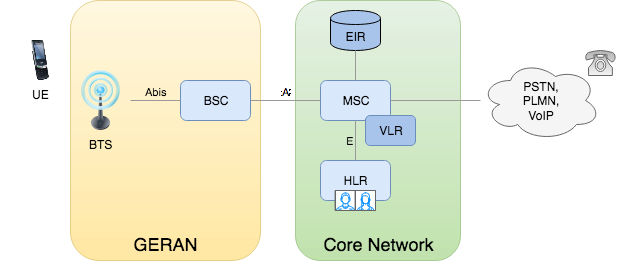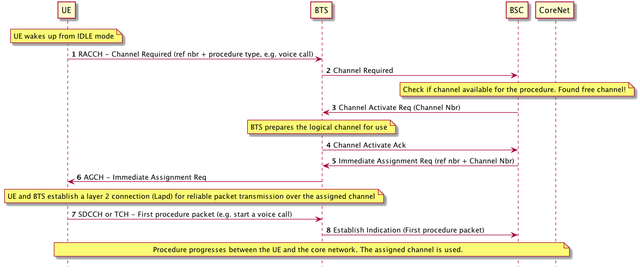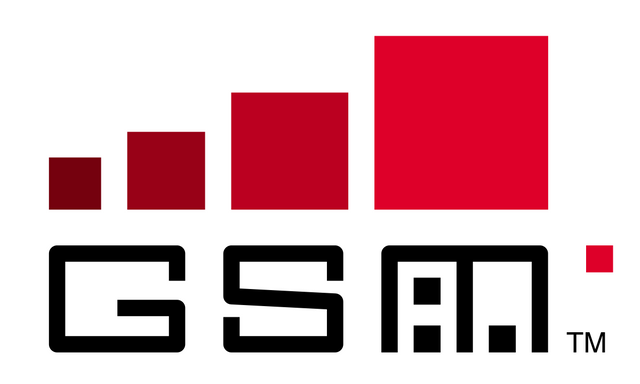Introduction to Mobile Networks - The GSM CS Architecture
Note: All illustrations with the exception of the GSM logo are my own design.
Work on the first GSM specifications started in the 1980's as a replacement for the first generation (1G) analog cellular system. The first specifications of this second generation (2G) network were published in 1987, result of a partnership between a few European countries. A few European operators pledged to invest in the new GSM network and on July 1st 1991 the first GSM call was placed.
In this first post about the GSM system I give an introduction to the architecture of the 2G network which provide Circuit-Switched (CS) services.
A service is circuit-switched in the sense that fixed network resources are assigned to the service.
For example, a CS voice call is a call to which a virtual connection (similar to a phone line) has been established between the UE and the operator's core network with a guaranteed bit rate. This resource is allocated to the voice call, even if the call itself only uses only a fraction of the bit rate at a single moment in time.
Architecture of the 2G CS Network
The following diagram illustrates the simplified CS part of a 2G network.
As indicated above and explained in our previous post Introduction to Mobile Networks, the operator's 2G network comprises the following domains:
- GSM Edge Radio Access Network (GERAN) - The part of the mobile operator's network in charge of managing the 2G radio resources.
- Core Network - The core network provides all of the core services (such as voice calls) provided to the UEs. The CS core network interconnects the subscribers with other telephony networks, such as a PSTN (Public Switched Telephone Network), another PLMN (mobile operator) or VoIP provider.
3gPP defines the logical connections between network elements as "interfaces". It assigns a unique small identity for each interface so as to easily refer to it in the specifications.
In the diagram above the following interfaces are shown:
- Um interface: Radio interface between UEs and BTS.
- Abis interface: Interface between a BTS and a BSC.
- A interface: Interface between a BSC and an MSC
- E interface: Interface between the VLR and the HLR.
Within the CS core network, we can find the following main network elements:
- Mobile Switching Centre (MSC) - Responsible for servicing all CS application procedures (mobility, messaging, voice calls, etc), switching calls with external telephony networks and forwarding SMSs to Short Message Service Centres (SM-SC)
- Visitor Location Register (VLR) - Stores key information about all subscribers attached the the group of cells that it manages.
- Home Location Register (HLR) - Stores all subscriber information such as IMSI, access and service rights, location information, etc.
- Equipment Identity Register (EIR) - Database of the IMEI numbers of blacklisted handsets.
Network elements within the GERAN domain are described in the next section.
2G Radio Access Network
The 2G RAN (GERAN) consists of 2 types of network elements:
- BTS (Base Transceiver Station) - This is the fixed radio element residing in the network providing radio transmission between GSM UEs (e.g. handsets) and the rest of the network. Traditional BTSs can be further sub-divided into baseband unit and radio heads with antenna, typically fixed to a mast
- BSC (Base Station Controller) - The BSC is the network element in charge of managing and assigning radio resouces to the BTS and the UEs (i.e., the "orchestrator" of radio resources).
GSM Radio Principles
In GSM each transceiver transmits on two individual 200kHz wide carriers. Each carrier is used for transmission in one direction only. One for the uplink and one of the downlink directions.
GSM uses a TDMA (Time-Division Multiple Access) mechanism to share radio resources between UEs and BTSs.
This means that 2 UEs attached to the same cell never transmit at the exact same time (with 1 exception), and a single BTS can only transmit to a single UE or broadcast information to all attached UEs at any given time.
GSM splits the time domain into 8 individual equal parts called time slots which repeat over and over again every 4.61538 ms.
Recall from the Introduction to Mobile Networks that specific types of traffic are transmitted over logical channels, such as Random Access Control Channel (RACCH), Broadcast Control Channel (BCCH), Paging Channel (PCH), Signalling Dedicated Control Channel (SDCCH) and Traffic Channel (TCH).
Logical channels can either occupy a full time slot (e.g. TCH) or fraction of a time slot (e.g. 1 time slot can host 8 SDCCHs).
Logical channel are thus identified by a Channel Number consisting of a time slot number (0 -> 7) and optionally a subchannel number.
GSM allows the operator to configure for each cell how logical channels are mapped to specific timeslots. Some restrictions applies, such as BCCH and PCH which must always be assigned to the first timeslot of the cell (TS0). This configuration is known has Channel Combination.
A typical Channel Combination for a cell could be:
TS 0: BCCH
TS 1: 8 SDCCHs
TS 2: TCH
TS 3: TCH
TS 4: TCH
TS 5: TCH
TS 6: TCH
TS 8: TCH
In this configuration the cell can support up to 8 simultaneous signalling procedures with UEs and up to 6 voice calls.
Channel Assignment Procedure
Let's examine now how a UE is assigned a logical channel in order to initiate a procedure such as a voice call.
The following diagram gives an overview of the procedure.
- The UE sends a Channel Required over the RACCH channel. This message carries a reference number and an indication of the procedure pending in the UE. As this channel is shared with all UEs on the cell there is a chance that another UE will also transmit a Channel Required at the same time. For this reason, the UE must be prepared to repeat the procedure in this unfortunate circumstance. The UE now listens on the Access Grant Channel (AGCH) for an Immediate Channel Assignment from the network. The AGCH is a type of downlink broadcast channel used by the network to indicate to the UE wether a channel has been assigned or a failure happened.
- The BTS forwards the Channel Required to the BSC. The BSC checks the pending procedure type in the Channel Required on finds an unused logical channel in the cell meeting the requirements of the procedure. The logical channel is now marked as used.
- The BSC sends a Channel Activate to the BTS with the Channel Number corresponding to the allocated logical channel and other key configuration parameters. The BTS then prepares the channel according to the information supplied in the message.
- The BTS sends back a Channel Activation Acknowledge to the BSC.
- The BSC sends an Immediate Channel Assignment to the UE. This message carries the reference number received in the Channel Required along with the Channel Number identifying the allocated logical channel.
- The Immediate Channel Assignment is forwarded to the UE over the AGCH. The UE and the BTS now negotiate establishment of a layer 2 connection in order to transfer reliably any further message over the allocated channel. In GSM the layer 2 protocol used is LapD.
- The UE now sends the first application level message over the layer 2 connection using the assigned logical channel.
- The BTS forwards the first application level message to the BSC, encapsulated within an Establish Indication (indicating that a new "connection" has been established with the UE). The application level procedure can now progress with the core network using the assigned logical channel.
What Next?
In the next post we will look at a concrete GSM procedure: the location updating procedure which is used by the UE to attach to a particular cell when powered on or when the UE decides to attach to another cell.
Acronyms and Concepts
| Acronym | Meaning | Description |
|---|---|---|
| AGCH | Access Grant Channel | A type of downlink broadcast channel used by the network to indicate to the UE if a channel has been assigned or not. |
| BSC | Base Station Controller | The network element in charge of managing and assigning radio resouces to the BTS and the UEs (i.e., the "orchestrator" of radio resources). |
| BTS | Base Transceiver Station | The element residing in the operator's network providing radio transmission between GSM UEs and the network |
| CS | Circuit-Switched | Virtual connection with fixed allocated network resources |
| EIR | Equipment Identity Register | Database of the IMEI numbers of blacklisted handsets. |
| GERAN | GSM Edge Radio Access Network (GERAN) | The 2G RAN |
| GSM | Global System for Mobile Communications | Name give to the second generation of mobile networks |
| HLR | Home Location Register | Stores all subscriber information such as IMSI, access and service rights, location information, etc. |
| MSC | Mobile Switching Centre | Responsible for servicing all CS application procedures (mobility, messaging, voice calls, etc), switching calls with external telephony networks and forwarding SMSs to Short Message Service Centres (SM-SC) |
| PLMN | Public Land Mobile Network | An operator providing mobile telecommunication services |
| PSTN | Publich Switched Telephone Network | A fixed (as opposed to mobile) telephone operator's network |
| RAN | Radio Access Network | Part of the mobile operator's network in charge of managing radio resources |
| TDMA | Time-Division Multiple Access | Mechanism whereby radio resources are assigned to UEs and BTS logical channels on a cyclic timely manner |
| TS | Time Slot | A time section during which a specific type of traffic can be transmitted over the radio interface |
| UE | User Equipment | Terminal used by the subscriber to access the mobile network, such as smartphone, modem, IoT device, etc. |
| VLR | Visitor Location Register | Stores key information about all subscribers attached the the group of cells that it manages. |
| Concept | Description |
|---|---|
| Downlink | Network to UE direction |
| Uplink | UE to Network direction |
Previous Posts in this Series
Introduction to Mobile Networks
References
3gPP 23002, GSM Network Architecture
3gPP 48.058, Base Station Controller - Base Transceiver Station (BSC - BTS) Interface
Mobile radio in interface layer 3 specification; Radio Resource Control (RRC) protocol (3GPP TS 44.018 version 13.0.0 Release 13)
As always do not hesitate to leave comments with your questions and I will make sure to reply with the best possible answers.

Congratulations! This post has been upvoted from the communal account, @minnowsupport, by irelandscape from the Minnow Support Project. It's a witness project run by aggroed, ausbitbank, teamsteem, theprophet0, someguy123, neoxian, followbtcnews, and netuoso. The goal is to help Steemit grow by supporting Minnows. Please find us at the Peace, Abundance, and Liberty Network (PALnet) Discord Channel. It's a completely public and open space to all members of the Steemit community who voluntarily choose to be there.
If you would like to delegate to the Minnow Support Project you can do so by clicking on the following links: 50SP, 100SP, 250SP, 500SP, 1000SP, 5000SP.
Be sure to leave at least 50SP undelegated on your account.
Hi all! For many people, it is very important to have a mobile connection that will not cost you much. Simple Mobile offers plans to fit any budget, with no hidden fees or contracts. By choosing Simple Mobile, you can enjoy unlimited talk, text, and data at a fraction of the cost of other mobile service providers. To choose the best tariff plan for yourself, just contact simple mobile and they will offer an option that will suit all your needs and budget.